jump start Mercury Sable 2002 Owner's Manuals
[x] Cancel search | Manufacturer: MERCURY, Model Year: 2002, Model line: Sable, Model: Mercury Sable 2002Pages: 240, PDF Size: 3.53 MB
Page 2 of 240
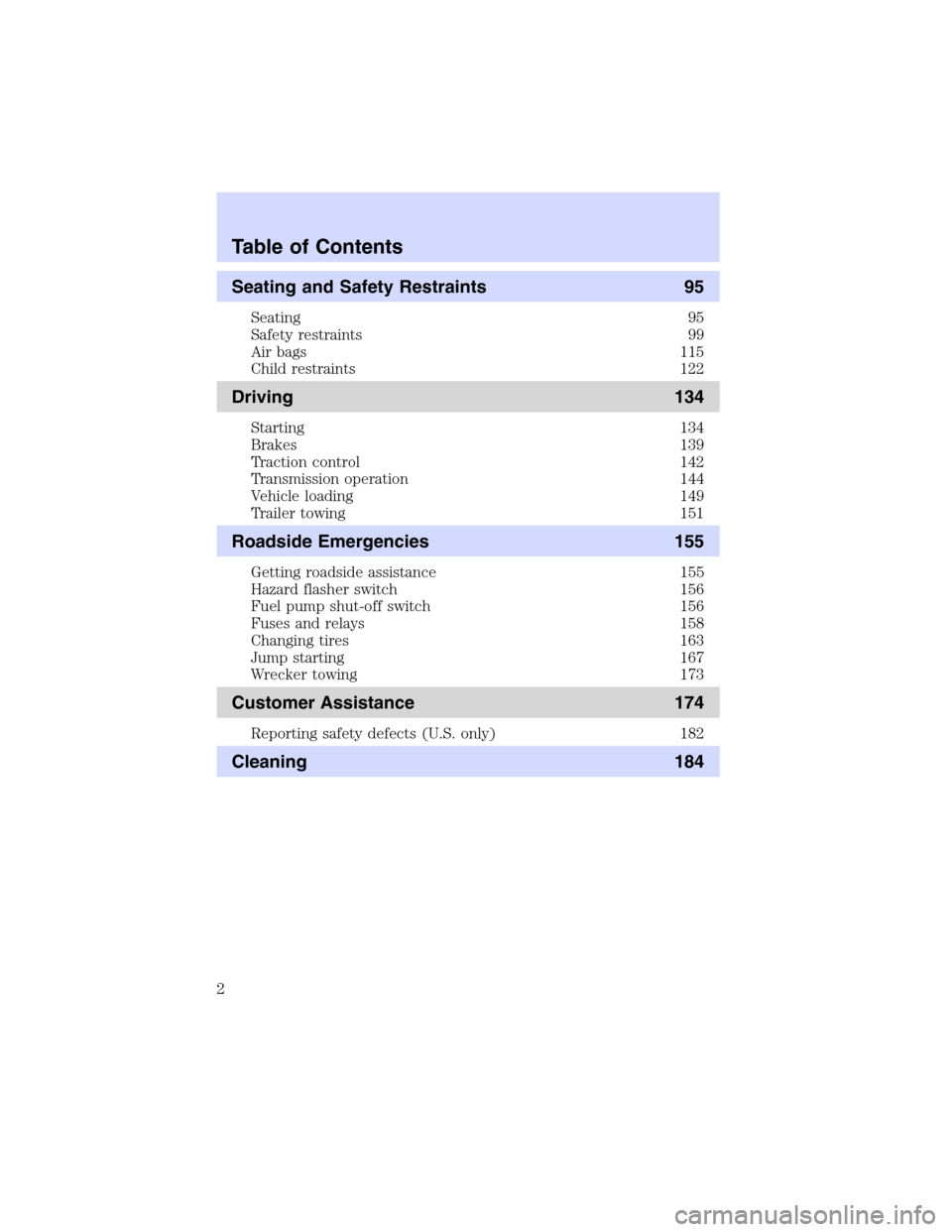
Seating and Safety Restraints 95
Seating 95
Safety restraints 99
Air bags 115
Child restraints 122
Driving 134
Starting 134
Brakes 139
Traction control 142
Transmission operation 144
Vehicle loading 149
Trailer towing 151
Roadside Emergencies 155
Getting roadside assistance 155
Hazard flasher switch 156
Fuel pump shut-off switch 156
Fuses and relays 158
Changing tires 163
Jump starting 167
Wrecker towing 173
Customer Assistance 174
Reporting safety defects (U.S. only) 182
Cleaning 184
Table of Contents
2
Page 155 of 240
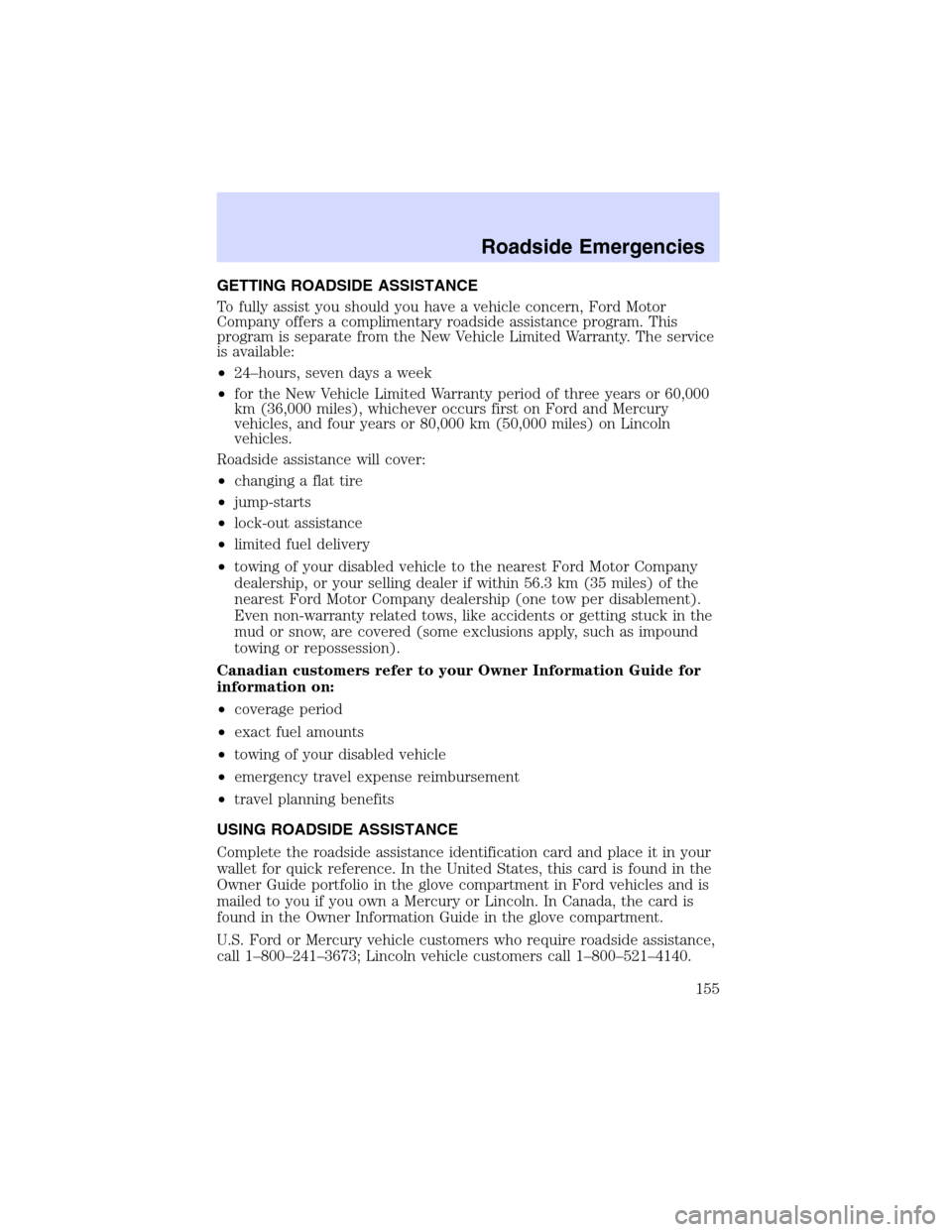
GETTING ROADSIDE ASSISTANCE
To fully assist you should you have a vehicle concern, Ford Motor
Company offers a complimentary roadside assistance program. This
program is separate from the New Vehicle Limited Warranty. The service
is available:
•24–hours, seven days a week
•for the New Vehicle Limited Warranty period of three years or 60,000
km (36,000 miles), whichever occurs first on Ford and Mercury
vehicles, and four years or 80,000 km (50,000 miles) on Lincoln
vehicles.
Roadside assistance will cover:
•changing a flat tire
•jump-starts
•lock-out assistance
•limited fuel delivery
•towing of your disabled vehicle to the nearest Ford Motor Company
dealership, or your selling dealer if within 56.3 km (35 miles) of the
nearest Ford Motor Company dealership (one tow per disablement).
Even non-warranty related tows, like accidents or getting stuck in the
mud or snow, are covered (some exclusions apply, such as impound
towing or repossession).
Canadian customers refer to your Owner Information Guide for
information on:
•coverage period
•exact fuel amounts
•towing of your disabled vehicle
•emergency travel expense reimbursement
•travel planning benefits
USING ROADSIDE ASSISTANCE
Complete the roadside assistance identification card and place it in your
wallet for quick reference. In the United States, this card is found in the
Owner Guide portfolio in the glove compartment in Ford vehicles and is
mailed to you if you own a Mercury or Lincoln. In Canada, the card is
found in the Owner Information Guide in the glove compartment.
U.S. Ford or Mercury vehicle customers who require roadside assistance,
call 1–800–241–3673; Lincoln vehicle customers call 1–800–521–4140.
Roadside Emergencies
155
Page 167 of 240
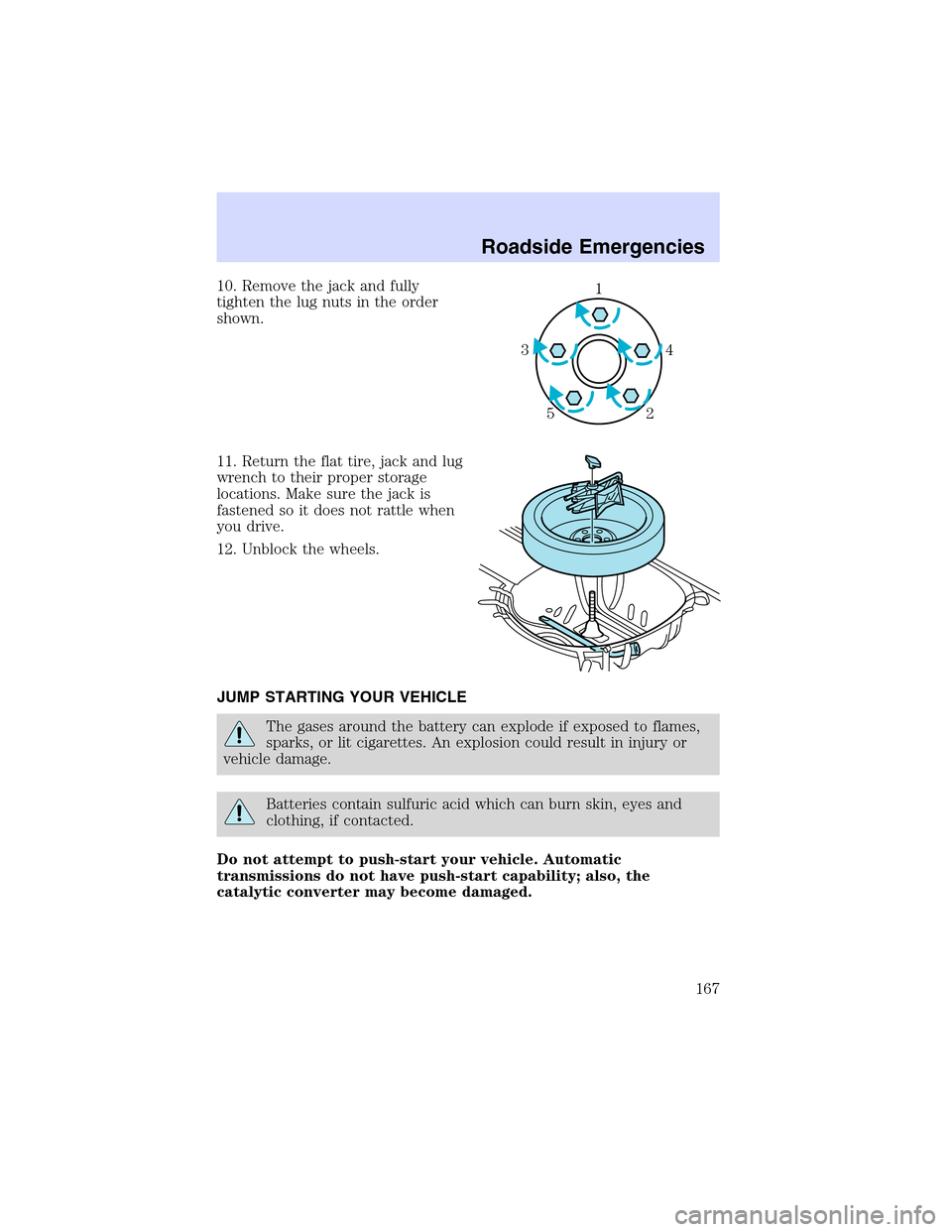
10. Remove the jack and fully
tighten the lug nuts in the order
shown.
11. Return the flat tire, jack and lug
wrench to their proper storage
locations. Make sure the jack is
fastened so it does not rattle when
you drive.
12. Unblock the wheels.
JUMP STARTING YOUR VEHICLE
The gases around the battery can explode if exposed to flames,
sparks, or lit cigarettes. An explosion could result in injury or
vehicle damage.
Batteries contain sulfuric acid which can burn skin, eyes and
clothing, if contacted.
Do not attempt to push-start your vehicle. Automatic
transmissions do not have push-start capability; also, the
catalytic converter may become damaged.
1
4 3
2 5
Roadside Emergencies
167
Page 168 of 240
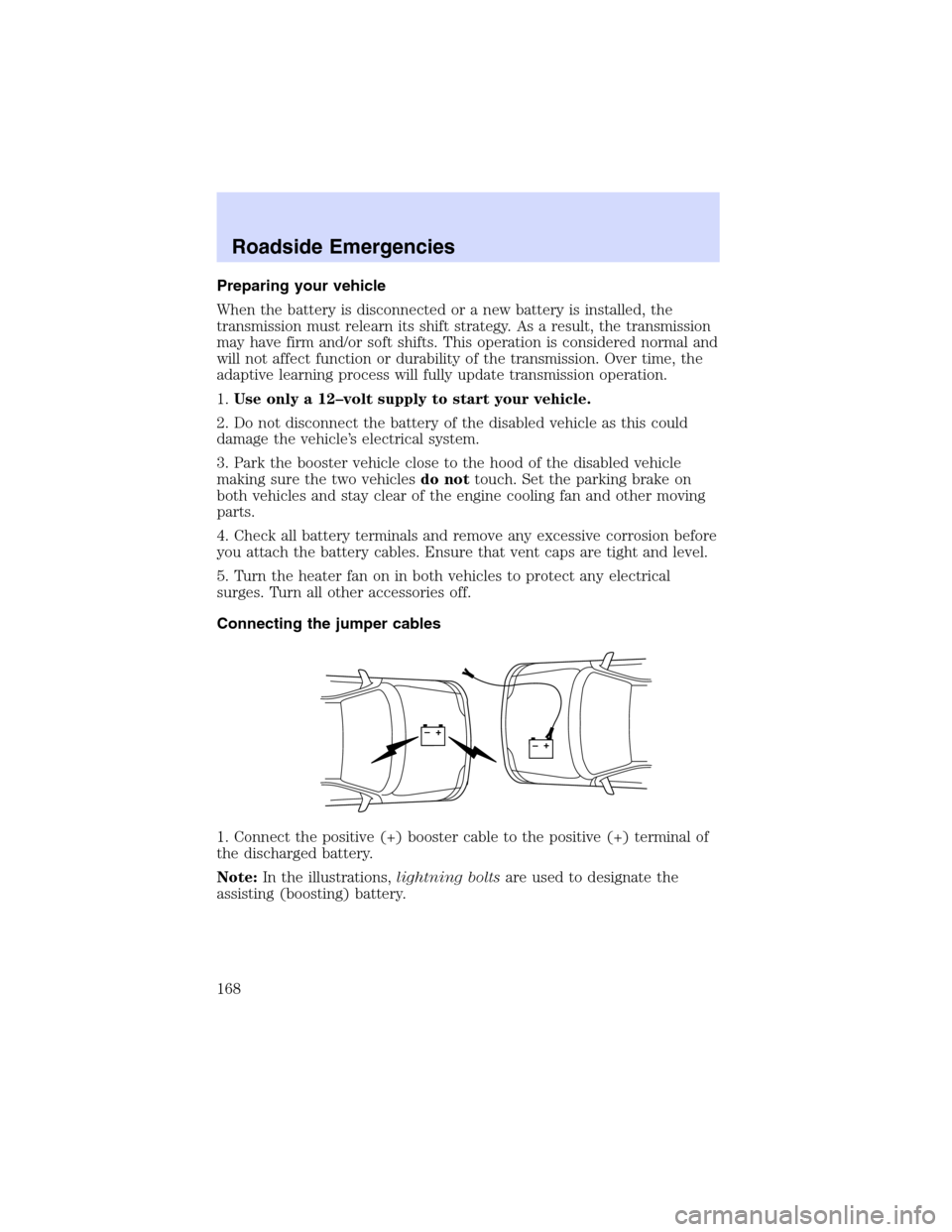
Preparing your vehicle
When the battery is disconnected or a new battery is installed, the
transmission must relearn its shift strategy. As a result, the transmission
may have firm and/or soft shifts. This operation is considered normal and
will not affect function or durability of the transmission. Over time, the
adaptive learning process will fully update transmission operation.
1.Use only a 12–volt supply to start your vehicle.
2. Do not disconnect the battery of the disabled vehicle as this could
damage the vehicle’s electrical system.
3. Park the booster vehicle close to the hood of the disabled vehicle
making sure the two vehiclesdo nottouch. Set the parking brake on
both vehicles and stay clear of the engine cooling fan and other moving
parts.
4. Check all battery terminals and remove any excessive corrosion before
you attach the battery cables. Ensure that vent caps are tight and level.
5. Turn the heater fan on in both vehicles to protect any electrical
surges. Turn all other accessories off.
Connecting the jumper cables
1. Connect the positive (+) booster cable to the positive (+) terminal of
the discharged battery.
Note:In the illustrations,lightning boltsare used to designate the
assisting (boosting) battery.
+–+–
Roadside Emergencies
168
Page 170 of 240

4. Make the final connection of the negative (-) cable. Make the
connection to an exposed metal part of the stalled vehicle’s engine, away
from the battery and the carburetor/fuel injection system.Do notuse
fuel lines, engine rocker covers or the intake manifold asgrounding
points.
Do not connect the end of the second cable to the negative (-)
terminal of the battery to be jumped. A spark may cause an
explosion of the gases that surround the battery.
5. Ensure that the cables are clear of fan blades, belts, moving parts of
both engines, or any fuel delivery system parts.
Jump starting
1. Start the engine of the booster vehicle and run the engine at
moderately increased speed.
2. Start the engine of the disabled vehicle.
3. Once the disabled vehicle has been started, run both engines for an
additional three minutes before disconnecting the jumper cables.
+–+–
Roadside Emergencies
170
Page 172 of 240

3. Remove the jumper cable from the positive (+) terminal of the booster
vehicle’s battery.
4. Remove the jumper cable from the positive (+) terminal of the
disabled vehicle’s battery.
After the disabled vehicle has been started and the jumper cables
removed, allow it to idle for several minutes so the engine computer can
relearnits idle conditions.
+–+–
+–+–
Roadside Emergencies
172
Page 236 of 240
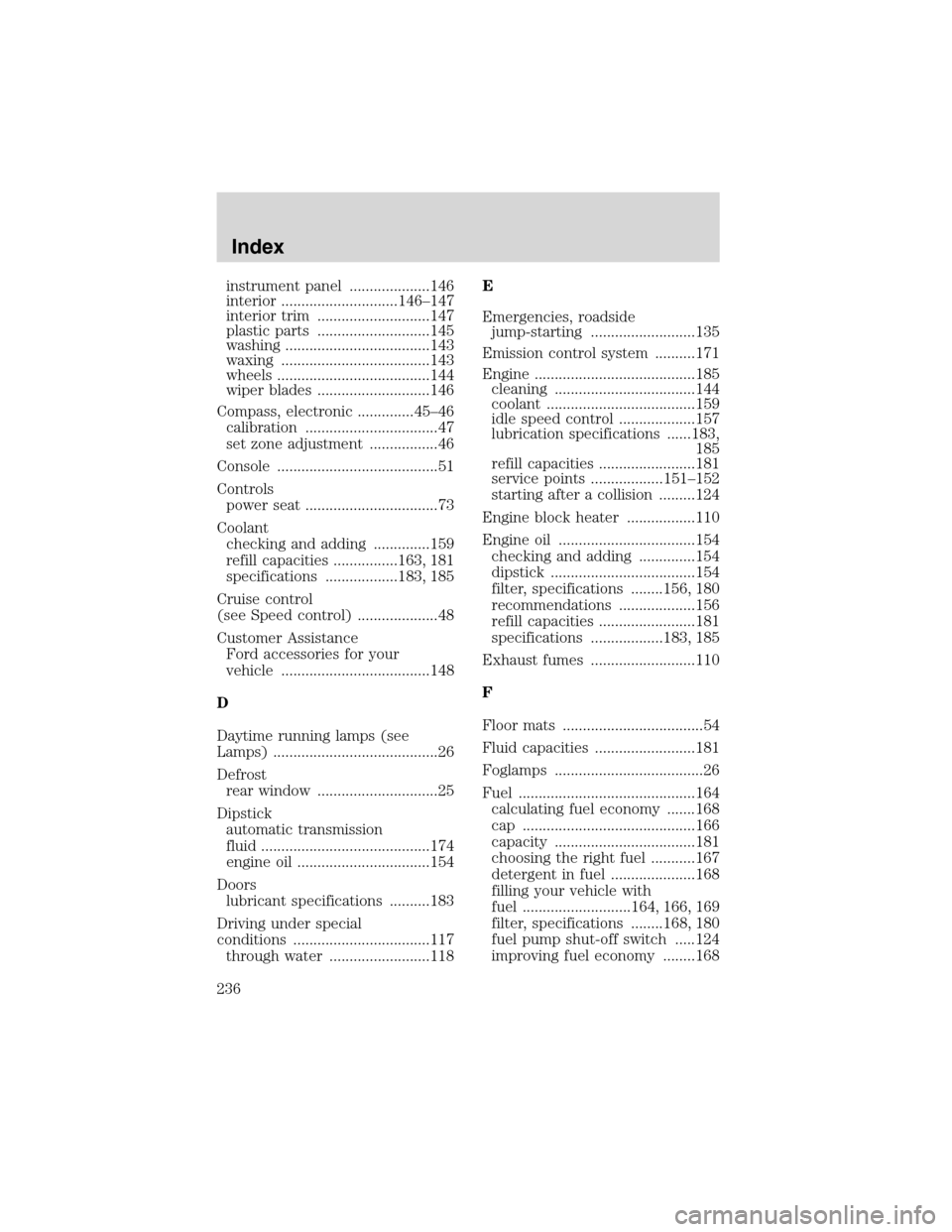
instrument panel ....................146
interior .............................146–147
interior trim ............................147
plastic parts ............................145
washing ....................................143
waxing .....................................143
wheels ......................................144
wiper blades ............................146
Compass, electronic ..............45–46
calibration .................................47
set zone adjustment .................46
Console ........................................51
Controls
power seat .................................73
Coolant
checking and adding ..............159
refill capacities ................163, 181
specifications ..................183, 185
Cruise control
(see Speed control) ....................48
Customer Assistance
Ford accessories for your
vehicle .....................................148
D
Daytime running lamps (see
Lamps) .........................................26
Defrost
rear window ..............................25
Dipstick
automatic transmission
fluid ..........................................174
engine oil .................................154
Doors
lubricant specifications ..........183
Driving under special
conditions ..................................117
through water .........................118E
Emergencies, roadside
jump-starting ..........................135
Emission control system ..........171
Engine ........................................185
cleaning ...................................144
coolant .....................................159
idle speed control ...................157
lubrication specifications ......183,
185
refill capacities ........................181
service points ..................151–152
starting after a collision .........124
Engine block heater .................110
Engine oil ..................................154
checking and adding ..............154
dipstick ....................................154
filter, specifications ........156, 180
recommendations ...................156
refill capacities ........................181
specifications ..................183, 185
Exhaust fumes ..........................110
F
Floor mats ...................................54
Fluid capacities .........................181
Foglamps .....................................26
Fuel ............................................164
calculating fuel economy .......168
cap ...........................................166
capacity ...................................181
choosing the right fuel ...........167
detergent in fuel .....................168
filling your vehicle with
fuel ...........................164, 166, 169
filter, specifications ........168, 180
fuel pump shut-off switch .....124
improving fuel economy ........168
Index
236
Page 237 of 240
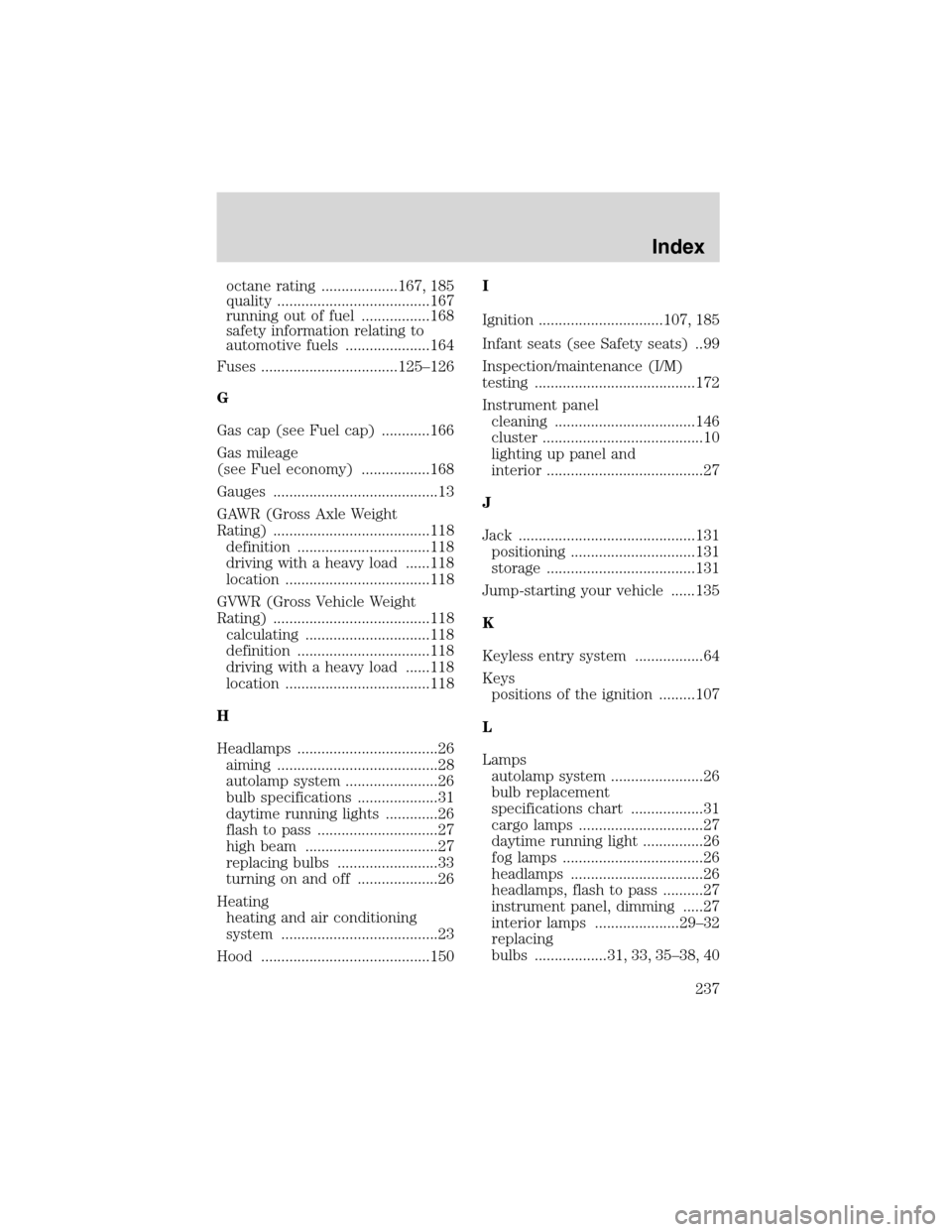
octane rating ...................167, 185
quality ......................................167
running out of fuel .................168
safety information relating to
automotive fuels .....................164
Fuses ..................................125–126
G
Gas cap (see Fuel cap) ............166
Gas mileage
(see Fuel economy) .................168
Gauges .........................................13
GAWR (Gross Axle Weight
Rating) .......................................118
definition .................................118
driving with a heavy load ......118
location ....................................118
GVWR (Gross Vehicle Weight
Rating) .......................................118
calculating ...............................118
definition .................................118
driving with a heavy load ......118
location ....................................118
H
Headlamps ...................................26
aiming ........................................28
autolamp system .......................26
bulb specifications ....................31
daytime running lights .............26
flash to pass ..............................27
high beam .................................27
replacing bulbs .........................33
turning on and off ....................26
Heating
heating and air conditioning
system .......................................23
Hood ..........................................150I
Ignition ...............................107, 185
Infant seats (see Safety seats) ..99
Inspection/maintenance (I/M)
testing ........................................172
Instrument panel
cleaning ...................................146
cluster ........................................10
lighting up panel and
interior .......................................27
J
Jack ............................................131
positioning ...............................131
storage .....................................131
Jump-starting your vehicle ......135
K
Keyless entry system .................64
Keys
positions of the ignition .........107
L
Lamps
autolamp system .......................26
bulb replacement
specifications chart ..................31
cargo lamps ...............................27
daytime running light ...............26
fog lamps ...................................26
headlamps .................................26
headlamps, flash to pass ..........27
instrument panel, dimming .....27
interior lamps .....................29–32
replacing
bulbs ..................31, 33, 35–38, 40
Index
237
Page 239 of 240
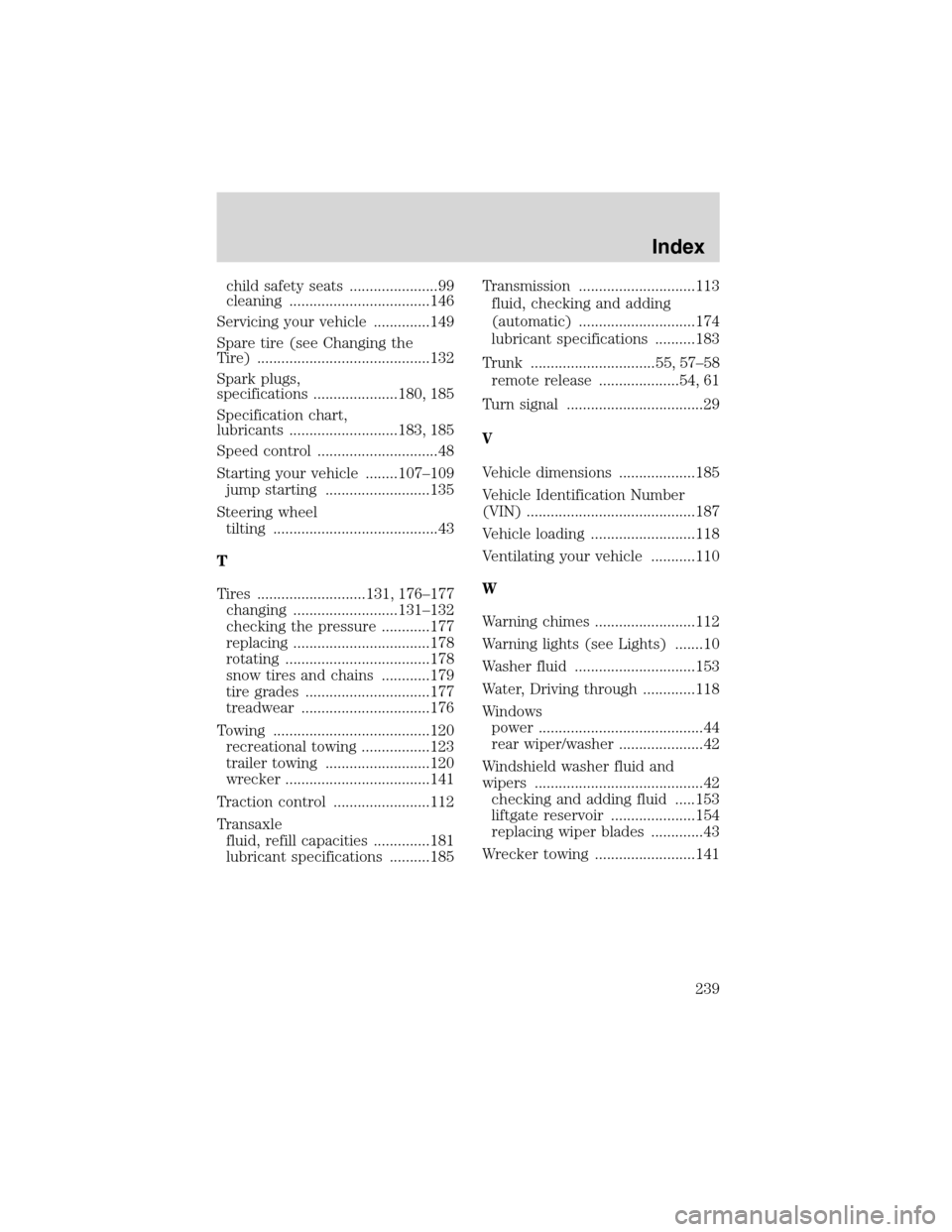
child safety seats ......................99
cleaning ...................................146
Servicing your vehicle ..............149
Spare tire (see Changing the
Tire) ...........................................132
Spark plugs,
specifications .....................180, 185
Specification chart,
lubricants ...........................183, 185
Speed control ..............................48
Starting your vehicle ........107–109
jump starting ..........................135
Steering wheel
tilting .........................................43
T
Tires ...........................131, 176–177
changing ..........................131–132
checking the pressure ............177
replacing ..................................178
rotating ....................................178
snow tires and chains ............179
tire grades ...............................177
treadwear ................................176
Towing .......................................120
recreational towing .................123
trailer towing ..........................120
wrecker ....................................141
Traction control ........................112
Transaxle
fluid, refill capacities ..............181
lubricant specifications ..........185Transmission .............................113
fluid, checking and adding
(automatic) .............................174
lubricant specifications ..........183
Trunk ...............................55, 57–58
remote release ....................54, 61
Turn signal ..................................29
V
Vehicle dimensions ...................185
Vehicle Identification Number
(VIN) ..........................................187
Vehicle loading ..........................118
Ventilating your vehicle ...........110
W
Warning chimes .........................112
Warning lights (see Lights) .......10
Washer fluid ..............................153
Water, Driving through .............118
Windows
power .........................................44
rear wiper/washer .....................42
Windshield washer fluid and
wipers ..........................................42
checking and adding fluid .....153
liftgate reservoir .....................154
replacing wiper blades .............43
Wrecker towing .........................141
Index
239